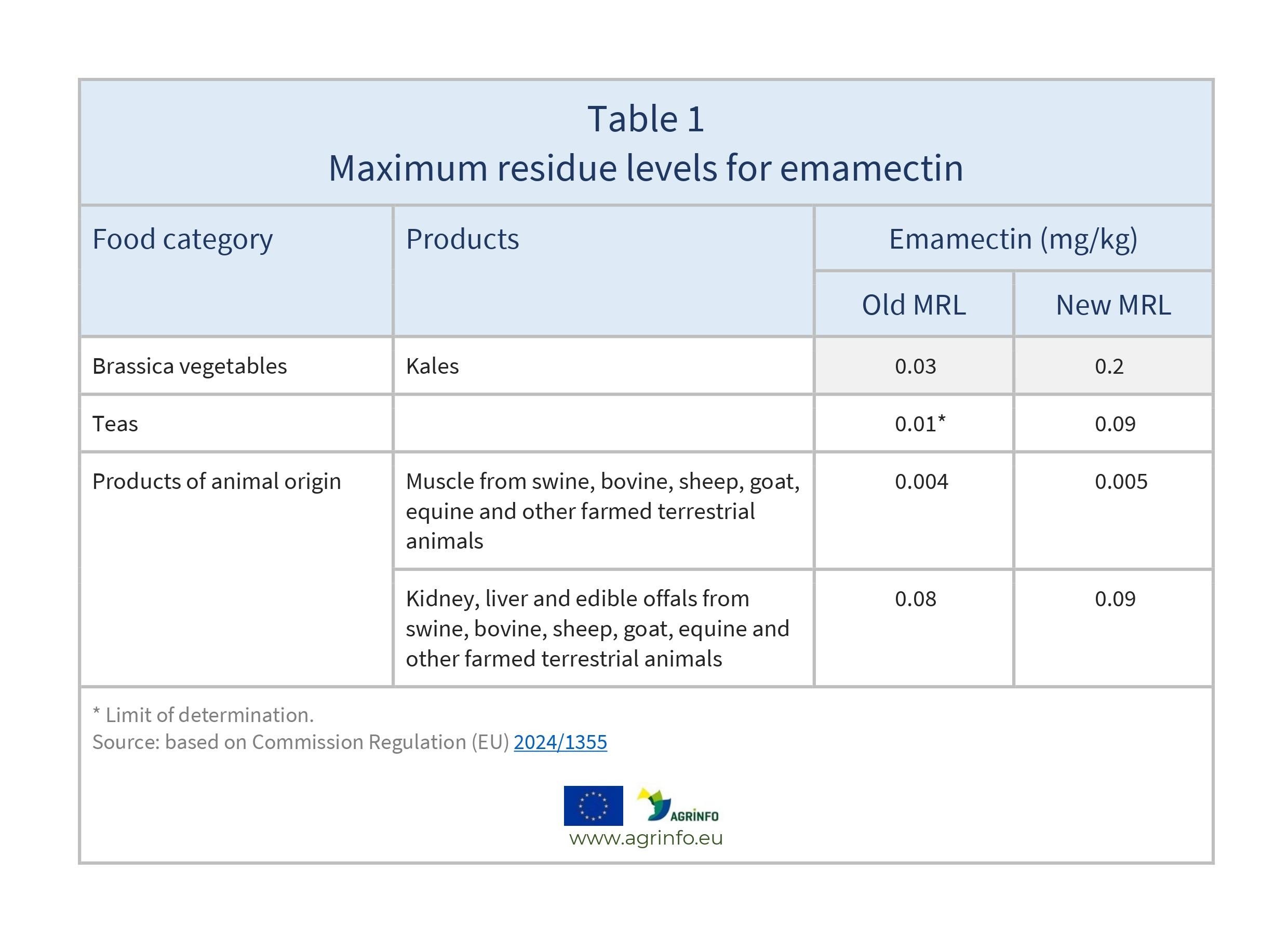Maximum residue levels for emamectin
- Pesticide MRLs
Summary
The EU has adopted Codex maximum residue levels (MRLs) for emamectin on kales, teas, and animal products. This follows changes to the MRLs for emamectin on specific fruit and vegetables, and reduced MRLs on plums, lettuces and salad plants, herbs, and globe artichokes, that have applied since February 2023.
EU aligns MRLs for emamectin on kales, teas, and animal products with Codex standards
Commission Regulation (EU) 2022/1343 of 29 July 2022 amending Annexes II and III to Regulation (EC) No 396/2005 of the European Parliament and of the Council as regards maximum residue levels for acequinocyl, chlorantraniliprole and emamectin in or on certain products
Commission Regulation (EU) 2024/1355 of 21 May 2024 amending Annexes II, III and V to Regulation (EC) No 396/2005 of the European Parliament and of the Council as regards maximum residue levels for benzovindiflupyr, chlorantraniliprole, emamectin, quinclorac, spiromesifen, and triflumuron in or on certain products
Update
The EU has adopted Codex maximum residue levels (MRLs) for emamectin on kales, teas, and animal products. This follows changes to the MRLs for emamectin on specific fruit and vegetables, and reduced MRLs on plums, lettuces and salad plants, herbs, and globe artichokes, that have applied since February 2023.
Impacted Products
oranges, lemons, mandarins, plums, table grapes, wine grapes, cucumbers, gherkins, courgettes, melons, pumpkins, watermelons, broccoli, cauliflowers, Brussels sprouts, head cabbages, Chinese cabbages, pe-tsai, Lamb’s lettuces, corn salads, cresses, sprouts, shoots, Roman rocket, rucola, red mustards, baby leaves, lettuces, escaroles, broad-leaved endives, watercresses, chervil, chives, celery leaves, parsley, rosemary, thyme, basil, edible flowers, laurel, bay leaves, tarragon, sage, beans (without pods), globe artichokes, animal products, kales, teas
What is changing?
The changes to emamectin MRLs on kales, teas and animal products are set out in Table 1.
The changes to emamectin MRLs that have applied since February 2023 are shown in Table 2.
Why?
On 2 December 2023, the Codex Alimentarius Commission adopted new Codex maximum residue limits (CXLs) for emamectin, for which the European Food Safety Authority (EFSA) did not identify risks to consumers in the EU.
The MRLs applying from February 2023 are a response to EFSA’s (2021) review of existing emamectin MRLs.
Timeline
The new MRLs on kales, teas, and animal products set out in Table 1 apply from 11 June 2024.
The MRLs for emamectin set out in Table 2 (Regulation 2022/1343) apply from 22 February 2023.
Background
MRLs are set in accordance with the rules set out in Regulation 396/2005. For information on current MRLs for other substances, please consult the EU Pesticide Residues database.
Resources
EFSA (2021) Modification of the existing maximum residue levels for emamectin in various crops. EFSA Journal, 19(8): 6824.
EFSA (2023) Scientific support for preparing an EU position in the 54th Session of the Codex Committee on Pesticide Residues (CCPR). EFSA Journal, 21(8): 1–303.
Sources
Tables & Figures

.

Disclaimer: Under no circumstances shall COLEAD be liable for any loss, damage, liability or expense incurred or suffered that is claimed to have resulted from the use of information available on this website or any link to external sites. The use of the website is at the user’s sole risk and responsibility. This information platform was created and maintained with the financial support of the European Union. Its contents do not, however, reflect the views of the European Union.
EU aligns MRLs for emamectin on kales, teas, and animal products with Codex standards
Commission Regulation (EU) 2022/1343 as regards maximum residue levels for acequinocyl, chlorantraniliprole and emamectin in or on certain products
Commission Regulation (EU) 2024/1355 as regards maximum residue levels for benzovindiflupyr, chlorantraniliprole, emamectin, quinclorac, spiromesifen, and triflumuron in or on certain products
What is changing and why?
The EU has aligned its maximum residue levels (MRLs) for emamectin on kales, teas, and animal products with MRLs adopted by Codex (see Table 1). This follows changes to MRLs for emamectin on specific fruit and vegetables, and reduced MRLs on plums, lettuces and salad plants, herbs, and globe artichokes, that have applied since February 2023 (see Table 2).
Timeline
The new MRLs on kales, teas, and animal products set out in Table 1 apply from 11 June 2024.
The MRLs for emamectin set out in Table 2 (Regulation 2022/1343) apply from 22 February 2023.
Tables & Figures

.

Disclaimer: Under no circumstances shall COLEAD be liable for any loss, damage, liability or expense incurred or suffered that is claimed to have resulted from the use of information available on this website or any link to external sites. The use of the website is at the user’s sole risk and responsibility. This information platform was created and maintained with the financial support of the European Union. Its contents do not, however, reflect the views of the European Union.
